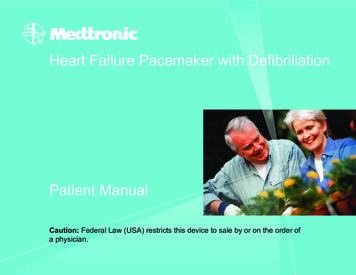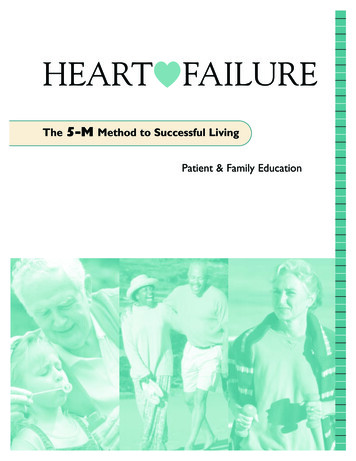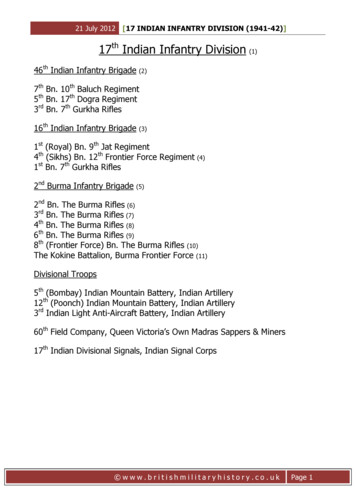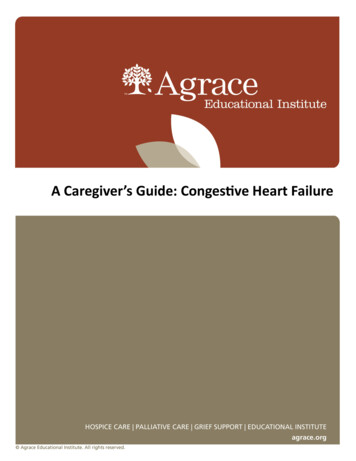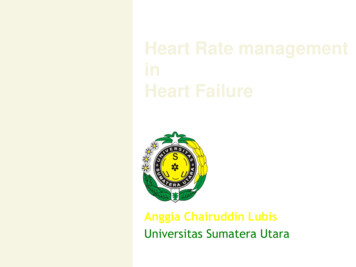
Transcription
Indian Heart Journal 73 (2021) 331e335Contents lists available at ScienceDirectIndian Heart Journaljournal homepage: www.elsevier.com/locate/ihjIVC filters - Indications for placement and retrieval trendseexperience from a tertiary referral centre in India type of submissionfull paperKartik P. Ganga a, Akash Vadher a, Vineeta Ojha a, Aayush Goyal b, Sanjeev Kumar a, *abDepartment of Cardiovascular Radiology and Endovascular Interventions, All India Institute of Medical Sciences, New Delhi, 110029, IndiaDepartment of Cardiothoracic and Vascular Surgery, All India Institute of Medical Sciences, New Delhi, 110029, Indiaa r t i c l e i n f oa b s t r a c tArticle history:Received 18 June 2020Accepted 14 January 2021Available online 20 January 2021Objectives: There is wide variation in the practice of IVC filter placement and retrievals. We conducted aretrospective study to identify the trends in placement and retrievals of IVC filters in a tertiary referralcentre in India.Methods: The data of patients obtained from our hospital records, in whom IVC filter was placed between 2010 and 2018, were analysed for demographics, indications for placement of IVC filter, underlyingcomorbidities, characteristics of the filters as well as the retrieval rates.Results: IVC filters were placed in 50 patients, and data was retrieved for 31 patients (mean - 51.24 years,67.74% males). According to ACCP/AHA guidelines, 24 (77.42%) had an absolute indication for IVC filter. All31 IVC filters were temporary, 23 (74.19%) of which were placed via femoral access. 29(93.55%) patientshad infrarenal IVC filter placement. The average tilt at deployment was 3.71 , whereas it was 5.3 atretrieval. There were no periprocedural complications or filter migrations during placement or retrieval.Retrieval was attempted in 11 (35.48%) patients and was successful in 10. The mean indwelling time inthis group was 158.55 days (range 55e366 days).Conclusion: Our study reveals low IVC filter implantation rates which are predominantly for absoluterather than relative indications. Though in sync with the worldwide trend, the poor retrieval rates reflectthe urgent need for better patient and physician awareness. Periodic follow up is imperative to improvethe IVC filter retrieval rate and to prevent complication rates. 2021 Cardiological Society of India. Published by Elsevier B.V. This is an open access article under theCC BY-NC-ND license ).Keywords:IVC filterRetrievalDeep vein thrombosis1. IntroductionIVC filter devices aim to prevent pulmonary thromboembolismin patients with lower limb deep venous thrombosis (DVT). Studieshave revealed that close to one-third of DVT patients are associatedwith pulmonary embolism.1 A study performed in the Indianpopulation showed similar results, with 23% of patients diagnosedwith DVT had associated pulmonary thromboembolism (PTE).2 Themainstay of treatment of patients with venous thromboembolism(VTE) is anticoagulation (AC) therapy with IVC filters being indicated in patients with absolute contraindication to AC (recentsurgery, a patient being planned for high-risk surgery, recent majorbleed etc.), response failure to AC therapy and complications arisingfrom AC therapy (or the risk thereof). IVC filters may also be prophylactically placed in high-risk patients, e.g. malignancy andmultiple comorbidities. We have conducted a retrospective study ofpatients requiring IVC filters over nine years in one tertiary carereferral centre in India. We aim to study the trends over the years ofIVC filter placement in this single centre retrospective study. Theindications, patient demographics, including comorbidities, historyof an adverse clinical event, history of prior episodes of DVT/VTEand IVC filter retrieval, were documented. The variant of IVC filterused, location of IVC filter and venous access site through which thefilter was placed was also recorded.2. Materials and methods* Corresponding author. Room no 10A, Department of Cardiovascular Radiologyand Endovascular Interventions, AIIMS, New Delhi, 110029, India.E-mail address: sanjeevradio@gmail.com (S. Kumar).Patients who underwent IVC filter placement from 1st January2010 till September 2018 were included in the study. Data of 32/ 2021 Cardiological Society of India. Published by Elsevier B.V. This is an open access article under the CC BY-NC-ND license ).
K.P. Ganga, A. Vadher, V. Ojha et al.Indian Heart Journal 73 (2021) 331e335All 31 (100%) patients had lower limb DVT when being considered for IVC filter, with 6 (19.35%) patients having a history ofchronic deep venous thrombosis. DVT was unprovoked in 12(38.71%) patients. The rest of the patients developed DVT either dueto a pro-coagulant state or due to prolonged immobilization. 22(70.97%) patients were undergoing AC treatment, which for reasonslisted below, required cessation of AC and necessitating the needfor IVC filter. 8 (25.81%) patients had a recent major bleed (intracranial bleed in 5 (16.13%) patients and massive hematuria in 3(9.67%) patients). In these patients, IVC filter placement was anabsolute indication as AC therapy was contraindicated. 7 (22.58%)patients with acute ileo-femoral DVT required an IVC filter placement with AC discontinuation before a major planned surgery. Amean interval of 7.77 days (Range- 0e20 days) was seen in patientsbetween the placement of IVC filter and surgery. IVC filter placement was required in 8 (25.81%) patients who failed to respond totherapeutic AC and continued to have clinically significant recurrent PE.One patient required an IVC filter because of massive gastrointestinal bleed developing after initiation of AC in a patient ofCrohn’s disease (a complication of AC therapy).Three patients were posted for pulmonary endarterectomy orembolectomy for chronic pulmonary thromboembolic pulmonaryhypertension and were considered as relative indications for IVCfilter placement (according to ACCP/AHA guidelines). In one patient, IVC filter was placed prior to catheter-directed thrombolysis(CDT) for an ileo-femoral DVT. The patient developed DVT withoutPE 18 days after radio-frequency ablation for cardiac arrhythmia.Two patients received a prophylactic IVC filter for highthrombus burden in the ileo-femoral/caval veins. One patient haddisseminated intravascular coagulopathy with PE for whom IVCfilter was placed despite therapeutic anticoagulation beingobtained.CDT was performed as an adjunct procedure in 3 patients. Twoof these patients had developed PE despite therapeutic AC. Onlyone of the patients with a high thrombus burden for which an IVCfilter was placed had a concomitant CDT as well.patients could be retrieved, and they were considered for the studywhile the rest of the patients with irretrievable records were onlyincluded in determining annual statistics. Demographic detailswith a detailed history of comorbidities including hypertension,diabetes mellitus, end-stage renal disease (ESRD), end-stage liverdisease (ESLD), ischemic heart disease, stroke, history of smoking,connective tissue disorder and malignancy, history of recentchemotherapy was taken. The indications for placement of IVCfilter and status of AC therapy at the time of insertion and afterretrieval were recorded, including mean time between retrievaland the study date. Also, details of IVC filters, i.e. device, nature(permanent/retrievable), venous access site, IVC filter location,adjunct procedure (e.g. catheter-directed thrombolysis) performedand retrieval status, and reason for non-retrieval were noted. Current status of treatment, i.e. whether the patient is receiving ACtherapy was also recorded.3. Results3.1. Patient demographicsOf the 50 filters placed between 2010 and 2018, the data andhistory of 31 patients were retrievable. Out of the 31 patients, 21(67.74%) were male patients, and 10 (32.26%) were females. Themean age of the study population was 51.45 years (Range-17-80years). Ten patients (32.26%) were suffering from hypertension, 6(19.35%) patients had diabetes, 6 (19.35%) patients were chronicsmokers, 3 (9.68%) were suffering from ESRD while none of themwere suffering from ESLD. 1 (3.23%) patient had a history of stroke,while none had ischemic heart disease or connective tissue disorder (Table 1).10 (32.26%) patients were undergoing treatment for cancer with4 (12.90%) patients amongst them undergoing chemotherapy at thetime of the procedure. Out of these ten patients, two patients hadbenign tumours (meningioma and pineal teratoma) while eightpatients had malignant tumours (2 patients each with renal cellcarcinoma and carcinoma colon; one each of carcinoma prostate,carcinoma ovary, carcinoma tongue and carcinoma cervix).3.3. IVC FILTER characteristicsAll 31 (100%) IVC filters placed were temporary filters; 4Gunther Tulip, 4-G2 RX Bard and 23 IVC Cook Celect filters. Majority of IVC filters were placed in infrarenal IVC, i.e. in 29 (93.55%)patients while in 2 (6.45%) patients it was placed in suprarenallocations. Filters were placed in the supra-renal location only inpatients who had DVT, which extended to the infra-renal inferiorvena cava. 23 (74.19%) IVC filters were placed through femoralvenous access (14 through right femoral route and 9 through leftfemoral route) while 8 (25.81%) filters were placed through jugularvenous access (7 through the right jugular and 1 through left jugular venous access). All the patients with jugular access hadbilateral iliofemoral DVT precluding a femoral approach.Out of the 31 patients, 2 (6.45%) patients required two attemptsfor IVC filter deployment. Rest of the 28 (93.55%) patients required asingle attempt during deployment. The average tilt angle of IVCfilters at deployment was 3.71 (range 1e10). Two patients had atilt angle of 20e30 during deployment, and the second attemptwas undertaken to deploy it. A Cook Celect filter was used in bothpatients with left femoral and right jugular access sites being used.None of the patients (0%) encountered access site complications.3.2. Indications for IVC FILTER placementThe indications for IVC filter placement were documented andstratified into absolute and relative indications according to themore stringent ACCP/AHA guidelines. Out of the 31 patients, 24(77.42%) had an absolute indication for IVC filter placement, while 7(22.58%) had relative indications. Table 2 shows the absolute andrelative indications for IVC filter in the study population.Table 1Baseline Characteristics of the study population.CharacteristicStudy population (n)Age, years (Range)Sex, no. (%)MaleFemaleHistory, no. (%)HypertensionDiabetesChronic smokersEnd stage renal diseaseStrokeMalignancy on treatmentBenignMalignantOngoing chemotherapy51.45 years (17e80years)31(67.74)21(32.26)10 (32.26)6 (19.35)6 (19.35)3 (9.68)1 (3.23)10 (32.26)2 (20.0)8 (80.0)4 (12.90%)3.4. Retrieval statisticsIVC filter retrieval was attempted in 11 (35.48%) patients andwas successfully retrieved in 10 (32.26%) patients. The percentage332
K.P. Ganga, A. Vadher, V. Ojha et al.Indian Heart Journal 73 (2021) 331e335Table 2Absolute and relative indications for IVC filter placement.INDICATIONS (n ¼ 31)n ¼ 24ABSOLUTE INDICATIONSContraindication to ACDue to major bleedPatients on AC posted for major surgeryFailure of response to ACComplication to ACRELATIVE INDICATIONSPrior to CDTPrior to CTEPHIleo-femoral DVT with high thrombus burden8781n¼7133Abbreviations: AC: Anticoagulation; CDT: Catheter directed thrombolysis; CTEPH: Chronic pulmonary thromboembolism induced pulmonary hypertension; DVT: Deep veinthrombosis.of retrievals increased from 27% for filters placed between 20102014 to 35% for filters placed between 2015e2018. Though thisupwards trend is encouraging, the overall rates of filter retrievalremain dismal. The mean interval between the date of IVC filterplacement and IVC filter retrieval interval was 158.55 days (range55e366 days). For the rest of the patients who did not undergo IVCfilter retrieval, all 20 (64.52%) patients were informed about theneed for filter retrieval during the placement as well as beingspecifically mentioned in the patient’s copy of the proceduralreport. Reasons for non-retrieval of IVC filters in the 20 (64.52%)patients in whom filter retrieval was not attempted- 9 (29.03%)were due to patient demise while 11 (35.48%) were due to lack ofclear instructions regarding follow up in the IR department. Theaverage indwelling period in the patients in whom IVC filterretrieval was not performed was 868.9 days (from the date of IVCfilter placement to the date of the study, Range-114-1969 days).Of the patients in whom IVC filter retrieval was attempted, 9(29.03%) patients had a perforation of IVC walls by the filter strutswith an average of 3.11 mm (Range 2e5 mm) of caval wall penetration. Out of the nine patients, 6 (19.35%) patients had significant( 3 mm) caval wall penetration. Migration of IVC filter was not seenin any of the patients in whom retrieval was performed or undertaken. Retrieval was performed after ensuring the conversion oforal anticoagulation to intravenous anticoagulation with theomission of the routine dose on the day of the procedure. Theaverage tilt angle at retrieval was 5.3 (Range 2e17 ). Out of the tenpatients in whom the IVC filter was retrieved, 4 (12.90%) patientsrequired complex techniques. Residual thrombus, which was notsignificant ( 25% of IVC filter volume) was seen in 4 (12.90%) patients during angiography prior to filter retrieval. Two attemptswere made in a patient with unsuccessful retrieval of a Cook Celectfilter (device being placed 275 days before retrieval attempt) withmultiple advanced retrieval techniques being used, with theexception of attempting a forceps retrieval (due to unavailability inour department at the time of the procedure). The tilt angle, in thiscase, was 17 with the presence of significant caval penetration.This patient was discharged with instructions for continuous oralAC. No periprocedural complications were encountered in any patient during the retrieval attempt. Figs. 1 and 2 depict a successfuland an unsuccessful attempt at retrieval of IVC FILTER, respectively.Out of 20 patients in whom filter retrieval was not performed, 11patients were alive at the time of the study. Out of these 11 patients,nine patients were on therapeutic AC therapy (8 patients onwarfarin and one on Rivaroxaban) while two patients were not onAC therapy. Out of the 10 patients in whom IVC filter was retrieved,seven patients were on AC therapy at the time of the study (6 onwarfarin and one on Injection Clexane) while three patients werenot on AC therapy. One patient in whom IVC filter retrieval was notsuccessful was on warfarin therapy at the time of this study.Fig. 1. Patient with successful retrieval of IVC filter. A, B. Computed tomography imageand angiography image shows a tilt angle of 2 in a patient who underwent IVC filterremoval. C. Fluoroscopy image shows the IVC FILTER being ensheathed. D. Postretrieval angiogram with visualisation of the left renal vein and no evidence of contrastleak from IVC.Nine patients of the 31 patients expired during the study period.The cause of deaths in the nine patients were as follows- 4 due toadvanced malignancy related complications, 1 due to complicationsarising due to traumatic SDH, 1 due to ICH and 1 due to advancedILD related respiratory failure. The cause of death was unknown inone patient. None of the cause of death in the 8 patients were due toPE or suspected PE. There was no episode of recurrent DVT in the 31patients with follow-up data.4. DiscussionPulmonary thromboembolic disease is a major cause ofmorbidity and mortality in patients with deep venous thrombosis333
K.P. Ganga, A. Vadher, V. Ojha et al.Indian Heart Journal 73 (2021) 331e335The IVC filters used in our institute were all temporary, yet theretrieval rate was very low. This finding is in concordance with theprevious studies. Reasons for poor retrieval rate was largely due tolack of proper guidance to the patient and poor follow up/referralback to the Intervention department. IVC filters should be removedas soon as the patient can be treated with therapeutic AC. Our studyand multiple studies prove the fact that emphasis should be madeon patient education regarding IVC filter retrieval and follow up.The complications of indwelling IVC filter are well known, andtherefore retrieval of IVC filter once the patient can be administeredwith AC is imperative. One of the dreaded complications of longduration IVC filter placement is IVC thrombosis12 which is morepronounced in patients with metastatic malignancy,13 which formsa major percentage of our patients. Although none of the patients inour study group developed these complications, this is likely due tothe shorter period of follow up of this study. A proper record of IVCfilter patients should be preserved and follow up to the intervention clinic should be mandatory. In non-compliant patients,reminder calls from the hospital should be made to emphasize thecomplications of IVC filter in situ and the need for its retrieval.Our study is limited by small sample size, and it is not feasible toextrapolate the findings of this study to a larger population. Secondly, more patients with absolute indications underwent IVC filterplacement in our institute. The low filter implantation rates andretrieval rates may be confounded by the relatively expensiveprocedure in a tertiary care facility predominately catering to thelower socio-economic strata of the population and also whereimplantation for a relative indication might not be financiallyfeasible. With the rise of Government insurance schemes in Indiacovering the procedure for the poor, the utilization of this procedure may improve in the future making effective communicationbetween patients, referring clinicians and interventionists moreimportant. The number of patients who might have chosen not toproceed with the procedure and their reasons could not be assessedin this retrospective study. Further data regarding thromboembolism scores and statistical comparisons with outcomes would havebeen ideal but was not the objective of the study.Fig. 2. Patient with unsuccessful retrieval of IVC filter. A. Computed tomography imagein a patient referred for IVC filter retrieval shows an increased tilt angle (17 ). B.Angiography image demonstrating the failure of capture of the IVC filter e likely due toendothelisation of the tip caused by tilting.of lower limbs. The mainstay of treatment is these patients is ACtherapy. A previous Indian study2 revealed up to 94% of VTE’s weretreated with AC therapy. However for patients who cannot betreated with AC therapy due to recent major bleed, recent majorsurgery or need for major surgery, the placement of IVC filters issupported by guidelines from American College of Chest Physician,3American Heart Association4 Society of Interventional Radiology5,6and American College of Radiology.7 In addition, failure of ACtherapy is considered to be an absolute indication by guidelines ofAmerican Heart Association,4 Society of Interventional Radiology5,6and American College of Radiology.7 The other indications, i.e. iliocaval deep venous thrombosis, massive pulmonary embolism,concomitant malignancy, prior to CDT etc. are considered relativeindications for IVC filter placement.Our study shows increased IVC filter placement up to 2013 witha subsequent reduction in the number of patients undergoing thisprocedure. Similar trends are also seen in previous studies8 wherethere was a reduction in IVC filter placements. These trends can beattributed to the revised guidelines being made more stringent bythe societies mentioned above.Male patients form a larger proportion of patients of venousthromboembolism, similar to previous studies.1,2,9 One study10 hasshown increased levels of homocysteine in males likely leading toincreased frequency of venous thromboembolism. Our study reveals the percentage of male patients undergoing IVC filter placement (67.85%) was more than double the number of female patients(32.15%) undergoing IVC filter placement.In a previous Indian study, the commonest comorbidities inpatients developing VTE were hypertension (25%) followed bydiabetes (19%) while only 7% of patients had a history of concomitant malignancy.2 Another Indian study showed malignancy (31%)as a common risk factor for the development of VTE.11 In our study,we found hypertension (28.57%), malignancy (28.57%) and diabetes(14.28%) as common comorbidities in patients who underwent IVCfilter placement.Contrary to previous studies that show a larger proportion ofpatients with relative indications for IVC filter placement, our studyshows that most patients had absolute indications for IVC filterplacement which can be attributed to the stringent patient selection criteria. The low number of procedures performed in ourcentre may also be in part explained by the unaffordability of theprocedure by the vast proportion of the low-income populationthat our centre caters to.5. ConclusionOur single centre study reveals the trends of IVC filter placementin a tertiary referral centre in India, which is concordant with theobservations made in previous studies except for more stricterpatient selection leading to a larger percentage of patients withabsolute indications undergoing IVC filter placement rather thanthose with relative indications. Poor retrieval rates of IVC filter areseen as with previous other studies, which need special attention topatient awareness to improve IVC filter retrieval rates. It should beemphasised that it is the responsibility of the interventionistplacing the filter to educate the patient regarding the importance offilter retrieval and risks involved if the filter is not retrieved. Periodic follow up is imperative to improve the IVC filter retrieval rate.ContributionsAll the authors contributed equally in preparation, design andfinal approval of the manuscript.FundingNil.Ethical approvalExempt.334
K.P. Ganga, A. Vadher, V. Ojha et al.Indian Heart Journal 73 (2021) 331e335Informed consent and consent for publication5.Obtained.Prior publications/presentation in any meeting6.Nil.7.Declaration of competing interest8.Nil.9.References10.1. White RH. The epidemiology of venous thromboembolism. Circulation.2003;107(23 Suppl 1):I4eI8.2. Kamerkar DR, John MJ, Desai SC, Dsilva LC, Joglekar SJ. Arrive: A RetrospectiveRegistry of Indian Patients with Venous Thromboembolism. Indian Journal ofCritical Care Medicine : Peer-Reviewedvol. 20. Official Publication of Indian Society of Critical Care Medicine; 2016:150e158, 3.3. Kearon C, Akl EA, Comerota AJ, et al. Antithrombotic therapy for VTE disease:antithrombotic therapy and prevention of thrombosis, 9th ed: American College of chest physicians evidence-based clinical practice guidelines. Chest.2012;141(2 Suppl):e419S. e96S.4. Jaff MR, McMurtry MS, Archer SL, et al. Management of massive and submassive pulmonary embolism, iliofemoral deep vein thrombosis, and chronic11.12.13.335thromboembolic pulmonary hypertension: a scientific statement from theAmerican Heart Association. Circulation. 2011;123(16):1788e1830.Kaufman JA, Kinney TB, Streiff MB, et al. Guidelines for the use of retrievableand convertible vena cava filters: report from the Society of InterventionalRadiology multidisciplinary consensus conference. J Vasc Intervent Radiol : JVasc Intervent Radiol. 2006;17(3):449e459.Caplin DM, Nikolic B, Kalva SP, Ganguli S, Saad WE, Zuckerman DA. Qualityimprovement guidelines for the performance of inferior vena cava filterplacement for the prevention of pulmonary embolism. J Vasc Intervent Radiol :JVIR. 2011;22(11):1499e1506.Fidelman N, AbuRahma AF, Cash BD, et al. ACR appropriateness criteria((R))radiologic management of mesenteric ischemia. J Am Coll Radiol : JACR.2017;14(5s):S266. s71.Shah M, Alnabelsi T, Patil S, et al. IVC filters-Trends in placement and indications, a study of 2 populations. Medicine (Baltim). 2017;96(12):e6449.Shah M, Alnabelsi T, Patil S, et al. IVC filtersdtrends in placement and indications, a study of 2 populations. Medicine. 2017;96(12):e6449.Pai N, Ghosh K, Shetty S. Cause of deep venous thrombosis and pulmonaryembolism in young patients from India as compared with other ethnic groups.Blood Coagul Fibrinolysis : an international journal in haemostasis and thrombosis. 2012;23(4):257e261.Lee AD, Stephen E, Agarwal S, Premkumar P. Venous thrombo-embolism inIndia. Eur J Vasc Endovasc Surg : the official journal of the European Society forVascular Surgery. 2009;37(4):482e485.Weinberg I, Abtahian F, Debiasi R, et al. Effect of delayed inferior vena cavafilter retrieval after early initiation of AC. Am J Cardiol. 2014;113(2):389e394.Mahmood SS, Abtahian F, Fogerty AE, et al. AC is associated with decreasedinferior vena cava filter-related complications in patients with metastaticcarcinoma. Am J Med. 2017;130(1):77e82. e1.
3.3. IVC FILTER characteristics All 31 (100%) IVC filters placed were temporary filters; 4-Gunther Tulip, 4-G2 RX Bard and 23 IVC Cook Celect filters. Ma-jority of IVC filters were placed in infrarenal IVC, i.e. in 29 (93.55%) patients while in 2 (6.45%) patients it was placed in suprarenal locations.
